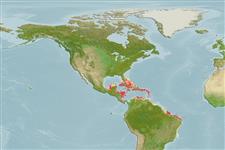>
Blenniiformes (Blennies) >
Tripterygiidae (Triplefin blennies) > Tripterygiinae
Etymology: Enneanectes: Greek, ennea = nine times + Greek, nektos = that swimms (Ref. 45335); quadra: Name from Latin, meaning square; for the characteristic squared shape of the dark caudal-peduncle bar; noun in apposition..
Environment: milieu / climate zone / depth range / distribution range
Écologie
marin récifal; profondeur 1 - 9 m (Ref. 116142). Tropical
Weatern Atlantic: the Caribbean, from the Bahamas, the Virgin Islands (USA), Antigua, as well as in the western Caribbean: at Yucatán, Mexico (as a larva), Honduras, Belize, and the offshore islands of Providencia.
Taille / Poids / Âge
Maturity: Lm ? range ? - ? cm
Max length : 2.4 cm SL mâle / non sexé; (Ref. 116142)
Description synthétique
Clés d'identification | Morphologie | Morphométrie
Épines dorsales (Total) : 15; Rayons mous dorsaux (Total) : 7; Épines anales: 2; Rayons mous anaux: 15. This species is distinguished by the following characters: orbital cirrus is dark and narrow, more than twice longer than wide, ending in a single point (rarely bifid); without scales on upper preopercle immediately behind eye, below sensory canal (one individual with one on one side); without dark spots along pored lateral-line; iris has 3 red, spoke-like bands at about 8, 10, and 1 o’clock with wide interspaces (as wide or wider than red spokes) and a red rear lower quadrant (when fresh); short snout with a reddish band from orbit across front half of upper and lower jaws, pale in preserved fish with only patches (not a complete band) of fine melanophores; presence of a short reddish bar extending from lower rim of orbit, when preserved only a short dark bar, not reaching past corner of jaw; usually a white patch immediately behind suborbital bar, when preserved only a scattering of fine melanophores; preopercle and opercle pale, except for reddish and dark patch at orbital rim at 5 o’clock and a bar along posterior margin of preopercle; rear body not red; anal fin barred, 6 to 8 dark patches corresponding to each body bar and mid-interspace; caudal-peduncle dark bar typically about square (same width throughout with corners squared) or slightly wider than high, extending onto caudal-fin ray insertions; caudal fin mostly unmarked, almost clear on preserved specimens, with faint melanin outlining ray shafts (Ref. 116142). Characters shared with Enneanectes jordani are the following: D III+XII+7; A II,15; pectoral-fin rays 15; short first dorsal fin when adpressed not reaching second-spine base of second dorsal fin (often not reaching fin origin); 13 modal pored lateral-line scales and about 19 or 20 scales in notched midline row; scaled belly and pectoral-fin base with two scales above rear of pored lateral-line, the upper scale much smaller [both characters of scaled-belly subgroup]; body bars 5 with the last body bar on caudal peduncle much darker; anterior orbital flange with fine spines (Ref. 116142).
Life cycle and mating behavior
Maturities | Reproduction | Spawnings | Egg(s) | Fecundities | Larves
Victor, B.C., 2017. The status of Enneanectes jordani and a new species of triplefin blenny from the Greater Caribbean (Teleostei: Tripterygiidae). J. Ocean Sci. Found. 27:48-73. (Ref. 116142)
Statut dans la liste rouge de l'IUCN (Ref. 130435)
Menace pour l'homme
Harmless
Utilisations par l'homme
Outils
Articles particuliers
Télécharger en XML
Sources Internet
Estimates based on models
Phylogenetic diversity index (Ref.
82804): PD
50 = 0.5001 [Uniqueness, from 0.5 = low to 2.0 = high].
Bayesian length-weight: a=0.00562 (0.00258 - 0.01228), b=3.08 (2.89 - 3.27), in cm total length, based on LWR estimates for this (Sub)family-body shape (Ref.
93245).
Niveau trophique (Ref.
69278): 2.9 ±0.3 se; based on size and trophs of closest relatives
Résilience (Ref.
120179): Haut, temps minimum de doublement de population inférieur à 15 mois (Preliminary K or Fecundity.).
Fishing Vulnerability (Ref.
59153): Low vulnerability (10 of 100).
